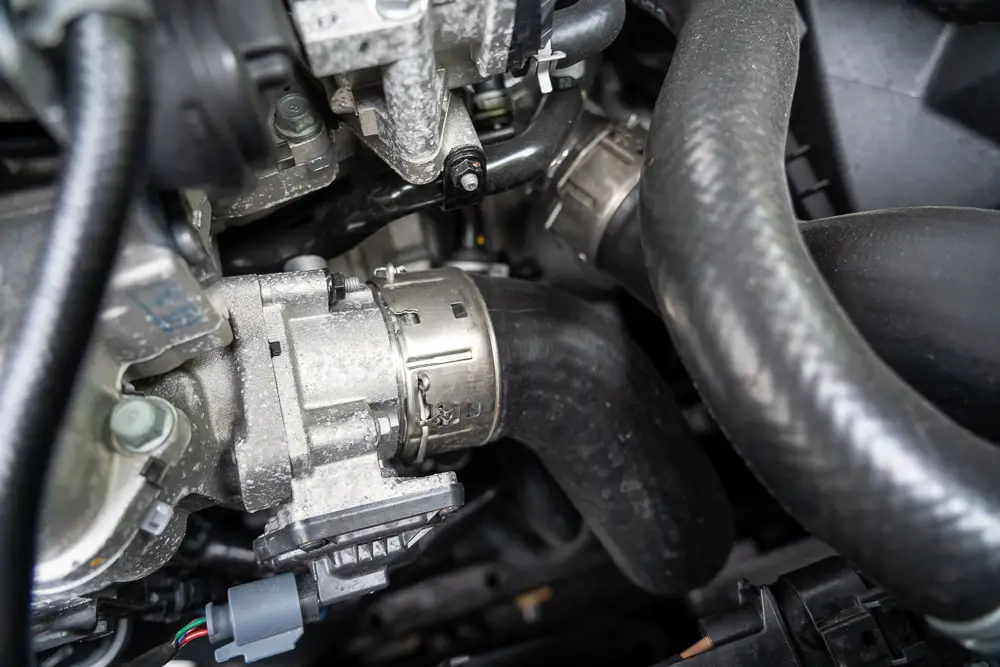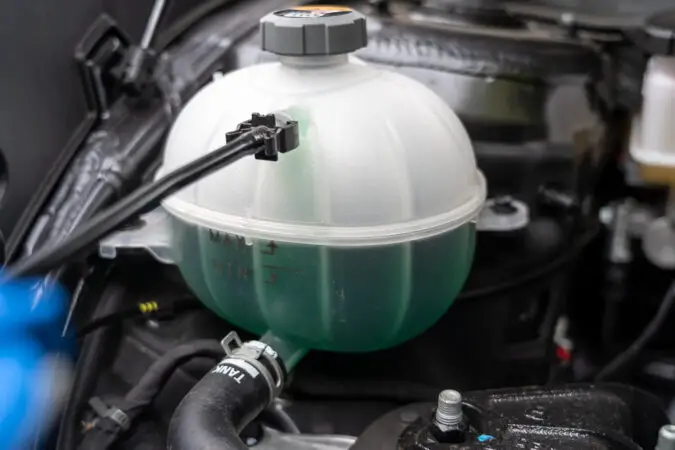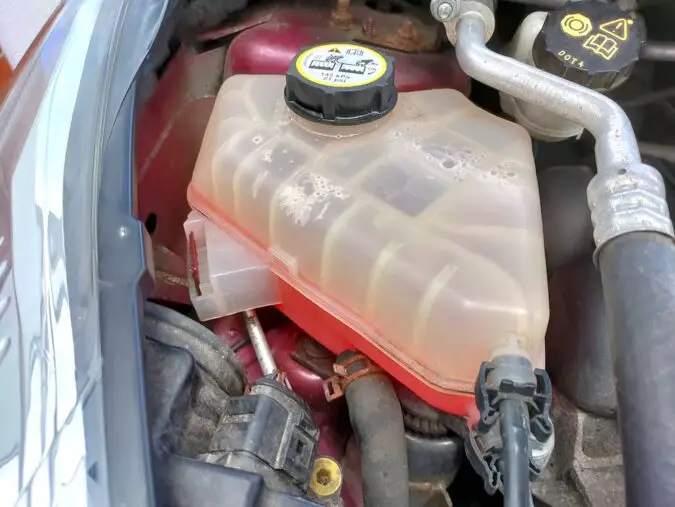The ECT sensor, short for engine coolant temperature sensor, is a negative temperature coefficient thermistor. What this means is that when the electrical resistance dips, the temperature goes up.
An ECT sensor is a key part of the engine management sensors. The readings provide vital information in calculations affecting overall engine performance.
The ECU or electronic control unit uses this data to maintain ignition timing and engine ignition. When the sensor sends abnormal data or doesn’t send a signal at all, the powertrain control module illuminates the check engine light. We call the ECT a thermistor as it changes resistance based on engine temperature.
Every driver is aware of the importance of antifreeze or coolant to keep the engine running at optimum temperature. How does a cooling system understand that the engine is operating at the correct temperature? This is where an ECT sensor comes in.
In today’s ECT sensor 101, we discuss this segment of the car, how to notice irregularities to solve them, and its maintenance.
- ECT Sensor
- Issues
- Spot Faults
- How to Test
- Replacing an ECT Sensor
- Maintenance
- Ignoring the Issue
- Conclusion
- FAQs
Coolant Temperature Sensor
In cars with internal combustion engines, the optimal temperature of the engine is regulated by the cooling system. It prevents the system from overheating. You can learn more in our guide on the normal temperature of a car.
An ECT or engine coolant temperature sensor calculates the cooling liquid’s temperature. The tip of the sensor extends into a cooling system passage and is dipped in the coolant.
Some cars have multiple coolant temperature sensors. For the majority of them, the main ECT sensor (number 1) is installed on the thermostat housing or by the thermostat inside the cylinder block or head. The 2nd ECT sensor can be located in the radiator or a separate part of the engine.
CHT or cylinder head temperature sensors are used instead of, or in addition to an engine coolant temperature sensor in some cars. The CHT sensor has similar working mechanisms to the ECT sensor but it counts the cylinder head’s temperature.
Moreover, it’s not dipped in coolant. This lets the sensor measure the engine’s temperature correctly even if there’s no coolant. Ultimately, that prevents overheating.
An ECT sensor has a direct link to the main computer, also known as the powertrain control module (PCM). The PCM delivers a reference voltage which is generally five volts and constantly observes the signals of the ECT sensor.
It then adjusts the performance of the engine based on the signal. After the temperature reaches a certain level, it starts the electric radiator fans.
ECT Sensor Problems
A common problem with the ECT sensor is when the sensor itself has a poor connection in the wiring harness or in the connector. This results in interruptions in the signals transmitted to the PCM.
Symptoms of this issue display as erratic temperature gauge readings in some cars. Or, the engine might operate in fail-safe mode: The radiator fans run constantly but the AC stops working.
Apart from that, some other check engine light codes associated with the ECT sensor could be caused by a handful of other reasons. For instance, problems with the cooling system, a bad thermostat (as is the case when you notice a P0128 code in your Jeep or a P0128 Dodge code), and a leak in the head gasket.
The issue has to be diagnosed. Since the ECT sensor isn’t really expensive, professionals and experts recommend you replace it the moment it starts malfunctioning.
Symptoms Of Bad Coolant Temp Sensor
Like every other component, ECT sensors could develop faults. As mentioned before, a faulty sensor can cause a range of problems, including poor engine performance and overheating.
You can spot the signs of a malfunctioning unit or failing sensor; it’s pretty easy. So, before the bad part does you more damage than you hoped for, here’s how to identify it:
Begin by checking out the unit. Inspect its condition. Gaskets, connectors, and can sensors can develop cracks due to prolonged use combined with continuous temperature cycling.
Usually, one can find the ECT at the front of the car, on the radiator, or close to the thermostat housing. A visual check would help you diagnose a few faults but not all ECT sensor errors have visible symptoms.
ECT Sensor Symptoms #1: Poor Fuel Economy
One of the main symptoms of faulty ECT sensors is poor fuel economy. Once the engine coolant temperature goes bad, it could send false signals to the computer. As a result, the timing and fuel calculations are mixed up. It’s pretty common for them to fail completely and transmit a permanently cold signal to the computer.
Naturally, the computer assumes the engine is cold although it isn’t and it consumes more fuel than needed. In essence, fuel economy is reduced and it could also be a barrier to smooth engine performance.
ECT Sensor Symptoms #2: Overheating Engine
For a system that literally keeps the engine cool, this problem exists without explicit mention. Overheating engines can be caused by the ECT sensors failing and sending a permanently hot signal.
The computer, thus, misperceives the temperature and compensates the wrong way for a lean signal. You would be lucky if the result was just an overheating engine and not something like an engine ping or misfires.
ECT Sensor Symptoms #3: Black Smoke from Engine
If you notice black smoke coming out of the vehicle’s exhaust, it’s a sign that the ECT sensor may be faulty. A failing coolant temperature sensor delivers a cold signal to the computer, confusing the computer into unnecessarily enriching the fuel blend.
An excessively rich fuel blend doesn’t burn properly in the combustion chamber and it also burns up inside the exhaust pipes. This comes out as black smoke from the exhaust chamber.
In severe cases, you could be asked to not drive the vehicle due to the volume of black smoke. White smoke poses different threats.
ECT Sensor Symptoms #4: Check Engine Light Flashes
A check engine light can mean so many things that it’s almost frustrating. Of course, it can also mean a bad ECT sensor. The check engine light remains on until you resolve the issue with the coolant temperature sensor.
However, not all vehicles illuminate the particular sign for ECT problems. Some more reasons why the check engine lights might be blinking are discussed here.
How To Test Coolant Temp Sensor
The tip of the ECT sensor needs to be immersed in the engine’s coolant. In the process, the air pockets or low coolant level in the cooling system can manipulate the sensor’s signals, giving the wrong information.
When dealing with any problem related to coolant systems, make sure to check the coolant level first. Make sure you check the ECT sensor connector for corrosion or damaged pins.
There are many ways you can test the ECT sensor. Refer to your owner’s manual to know the model way. This video would also be helpful.
Option 1: Testing The Resistance
Resistance is the main data the ECT sensor relies on to regulate temperature. You can measure the sensor’s resistance at varying engine temperatures and analyze and compare the results to the specifications mentioned in the owner’s manual.
A sensor’s resistance can only be measured once the connection between that and the circuit is broken. The reason behind this is that if you take the resistance reading of any electrical component still in contact with the circuit, you won’t get an accurate measurement.
Just to better explain the changes between resistances when an engine is hot/cold: A cold engine could give a resistance reading of 2,900 Ohm. If you take the measurement after the engine has been warmed up fully, it won’t cross the 250 Ohm mark. The resistance specs differ between cars of different models and make.
Option 2: Checking The Voltage
Another way to check the ECT sensor is to gauge the voltage running between the sensor terminals. You need to have the ignition on for this one.
The sensor is linked to the engine computer or PCM. The PCM supplied about 5 Volt of reference voltage; another wire is deemed the sensor ground. You must check both the ground and reference voltage when starting. As the sensor’s resistance drops with the rising warmth of the engine, the voltage reduces too.
Bringing up the example of a random car, let’s assume it reads 4 Volt when cold. Had the engine been fully warmed up, the voltage would drop sharply, hanging around the 1 Volt mark. Since the sensor isn’t connected, the multimeter will give a reading of 5 Volts.
If there’s no voltage, that means the circuit is shorted to ground or open. For instance, one of the wires from the sensor harness can snap or brush up against a short out and metal part.
Compare the ECT sensor reading to the other temperature measurements. You could analyze it beside the intake air temperature or IAT sensor. If the car was sitting in parking mode overnight, the ECT measurement and the IAT sensor’s measurement should be rather close; by that, we mean a difference of 2°F to 3°F. The ECT sensor reading would be lower.
You can learn more about diagnosing this in our guide on the P0113 Jeep code or the P0113 Dodge code. A minor difference exists because the air heats up much faster in the morning in comparison to the metal engine. Had the difference been greater, it would entail that any of the sensors are giving the wrong reading.
Option 3: Troubleshooting Intermittent Issues
Do the problems in your ECT sensor keep going away only to come back every few days? Frustrating, we know. If there’s an issue like that with your CHT sensor tool, a scan tool is used to diagnose it.
A mechanic connects the scan tool and uses it to monitor the sensor voltage. They lightly tap on the sensor while wiggling the connector along with the harness. A voltage change means that there’s a problem area. One other option is to observe the ECT temperature.
Coolant Temperature Sensor Replacement
Replacing an ECT or CHT sensor is quite simple. It will be easier for anyone who is familiar with the bits and pieces of an engine. Additionally, it can be done on your drive. Don’t want to spend money on replacing the sensor? No worries, we have you covered. Just follow the step-by-step process to change a bad engine coolant temperature sensor in your vehicle.
Step 1: Find The Sensor
The ECT sensor is installed in different places based on the make, brand, and model of the car. However, generally, it is close to the thermostat of the cooling system. Or it might be inside it.
As mentioned before, there may be more than one temperature sensor in a car. One of them sends information to the control unit from the engine system whereas the other does the same between the dashboard and the control unit. However, some vehicles make do with just one sensor and it works fine.
If your car has 2 sensors, one is the coolant temperature sensor or ECT sensor. On the other hand, the other is termed the coolant temperature sending unit. This is what sends information to the dashboard of the car from the control unit.
Step 2: Detach The Connector Cable
The ECT sensor is linked to the ECU by a connector. You have to loosen and then remove it. Maintain a steady, careful hand while doing this as the wiring and plastic connector can often be brittle. You will have to replace the entire thing if you mistakenly break it. Disconnect the link and set the cables aside for the time being.
Step 3: Unfasten And Get Rid Of The Old Sensor
Coolant sensors feature a spark plug fit, so you have to unscrew the thing to detach it. Use a ratchet and deep socket to carefully unfasten the sensor – make sure to move in an anticlockwise direction.
Don’t apply too much pressure. If the sensors are jammed, a bit of release spray could free it up. Once that’s done, unscrew it by hand and take it out of the socket. Keep a new sensor ready by your side as coolant will most likely start to leak out at this stage. Consider draining the liquid if needed.
Step 4: Install The New Sensor
Clean the debris and dust off the area with a rag or cloth. It goes without saying that dirt could mess with the performance of your new ETC. Place the replacement sensor between the threads and with your hand, twist it clockwise.
The sensor has to fit properly in the socket otherwise it won’t work. Now, pick up a torque wrench and fasten the sensor to the count mentioned in the owner’s manual. The manufacturer will surely have provided some instructions.
Step 5: Reconnect The Connector Cable
Your new sensor is positioned so now the only thing left to do is reinstate the connection. Clean the connector of any dirt or debris (if any) and plug it into the sensor carefully. If there are any clips on the side, properly tighten them to ensure a perfect line with the terminal.
It’s time to check whether the new sensor is doing its work or not. Start the engine and let it warm. As it heats up, observe the dash’s temperature gauge to ensure the right temperature is being maintained.
ECT Sensor Maintenance
Nothing lasts forever. And chances are, neither with the ECT sensor of your car. Granted these things were designed to last for a long time but there are instances when the promise is broken. As with any mechanical item, problems can arise if you don’t maintain it properly. You could go lazy now, thinking it won’t be any hassle.
However, the possibility of a future financial strain will always be looming over your head. Make sure to regularly conduct maintenance checks and necessary repairs on the ECT sensors of your car so they work at an optimal level.
Below we have mentioned some ways to avoid problems with the engine coolant temperature sensor.
ECT Sensor Maintenance Tip #1: Tap Water Is A Big No-No
It’s the first and foremost thing about cars. Never refill the radiator with tap water. Also, try not to use tap water for the coolant reservoirs. When you fill tap water into reservoirs, it can produce a coolant leak.
Generally, tap water is teeming with particles of rust as well as other minerals that would be detrimental to the lifespan and performance of the car in the long run.
This is more noticeable if the water starts to boil, as it will then evaporate inside the radiator. One of the very common problems people face with their cars is a leaking radiator.
When you use a proper coolant, it doesn’t let the water boil. On top of that, it does a much finer job at lubricating. When lubrication is spread over the radiator and engine block, rust isn’t allowed to form on the inside components of the car. For that, you need to use the right ratio of coolant and water in your car.
ECT Sensor Maintenance Tip #2: Fix Oil Leaks Quickly
If you see any gasket leaks or oil leaks at all, try to fix them as soon as possible. Most of the oil leaks are a result of oil pan leaks, damaged engine gaskets, and/or poor connections. Coolant gets contaminated with oil if the latter manages to enter the engine block. “Polluted” coolant reduces the temperature sensor’s life.
The blend of oil and coolant will damage the ECT sensor pretty badly. Aside from that, high oil consumption usually indicates a serious problem in your engine. Don’t be surprised to find corrosion there as well.
ECT Sensor Maintenance Tip #3: Fix Coolant Leaks Immediately
Last but not the least, you have to repair the coolant leaks instantly. The cooling system your car has is a sealed type, which means you won’t have to fill water in the reservoir all that often.
If there is antifreeze leaking, this can happen alongside the coolant at the reservoir. The ECT sensor may give wrong readings if there’s not adequate coolant within the system. Needless to say, it negatively affects engine lifespan and performance.
How Much Is A Temperature Sensor
The average cost for replacing an engine coolant temperature sensor ranges between $200 to $260. Labor cost has to be paid separately and that could be about $140 to $185 on average. However, the parts themselves are not more than $70.
Can You Drive With A Bad Coolant Sensor
We get it, you don’t have the funds to repair your ECT sensor at the time. Nothing to be worried about! You can do some temporary fixes to keep everything together till you can invest in a replacement.
Check on other parts of your car to make sure they are working properly. If the car isn’t working well in general and has its best years behind it, you may want to consider selling it off.
ECT Sensor: Conclusion
Over time, general wear and tear can make the ECT sensor erode. By its very nature, the engine coolant temperature sensor is made to be fully immersed in coolant. But, it won’t work properly if there isn’t enough coolant in there.
Furthermore, engine coolant stops the water from boiling and evaporating through the cracks. It lubricates the radiator and engine block too, preventing the formation of rust. In conclusion, make sure to use the right blend of antifreeze and water in your engine to give it the gift of a longer life. When in doubt, bring the owner’s manual out.
FAQs On ECT Sensor
If you’re still curious to learn more about the ECT sensor, our FAQs here might help…
What Should Coolant Temp Be
The ideal temperature for your car’s coolant actually varies from one vehicle to another. For the most part, though, the temperature of the coolant in most vehicles should be around 195 to 220 degrees Fahrenheit. Or, that’s around 75 to 195 degrees Celsius. Although, most vehicles don’t show precise coolant readings. Instead, you can see how your typical temperature gauge on the dashboard shows LOW and HIGH readings, with a simple, unnumbered scale in the middle. If you want to find out precisely what those upper and lower limits are, you can always refer to your owner’s manual. If you notice that the coolant temperature reading is higher than this, you should be wary, as it’s a sign that your engine is beginning to overheat.
How To Bypass Coolant Temp Sensor
Bypassing a coolant temperature sensor is both complex and isn’t recommended. For starters, there are no benefits to bypassing it, since the ECT sensor tells the engine’s ECU how hot or cold the engine is. With this information in mind, the ECU can best monitor your engine’s cooling system. By removing or bypassing the ECT sensor, the ECU will now manage the engine as if it’s cold all the time. This can be detrimental to the engine’s well-being and performance. However, the only reason why you would want to bypass the coolant temperature sensor is if you want to test it. The ECT sensor is a variable resistance device and outputs varying signals depending on what temperature it’s reading. To bypass it, you’ll have to substitute this signal.
What Is A ECT Sensor
The ECT sensor is also known as an Engine Coolant Temperature sensor. As its name implies, the primary function of this sensor is to monitor the temperature of your engine’s coolant. In so doing, the ECT can better understand how hot (or cold) your engine is, simply by the heat that the coolant is giving off. With this data and input, the ECT sensor could then inform your car’s central computer (the ECU) on how to best manage your engine’s cooling system. For example, if the ECT is reading an overly high temperature, the ECU might take active measures to help cool your engine. While it doesn’t directly control the circulation of the coolant, the ECT sensor’s input might prompt the ECU to, for example, ramp up the radiator fans to cool the engine a bit better.
Where Is Coolant Temperature Sensor Located
Most vehicles have several coolant temperature sensors at a time, which ensures that your car’s computer (the ECU) is acutely aware of how hot (or cold) the engine actually is. For the most part, the primary ECT (engine coolant temperature) sensor is often found either on the thermostat housing. Or, near and around the thermostat by the engine block or cylinder heads. Meanwhile, there’s usually at least one backup ECT sensor found within or around the radiator. For the most accurate results, the ECT sensors would be installed in such a way that the tips of the sensor are dipped directly into the coolant. Meanwhile, some cars might also have a CHT (cylinder head temperature) sensor, which doesn’t need to be dipped in coolant to be able to measure temperature accurately.
How Do Temperature Sensors Work
To ensure the most accurate results, the engine coolant temperature sensors have their tips immersed in coolant. It works quite simply by measuring the temperature of this coolant. Thus, allowing it a better understanding of how hot or cold your engine is. The ECT (engine coolant temperature) sensor then passes along all that data to the ECU (your car’s computer brain). It does so by sending the ECU electric signals, corresponding with the temperature of the coolant. Initially, the ECU sends the ECT sensor a 5V (typically, though it might differ) reference voltage. The changes in voltage will let the ECU know the coolant’s temperature. From there, the ECU can take active steps to help cool down (or heat up) your engine, such as ramping up the radiator fans or using a richer fuel mixture.




